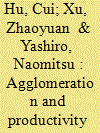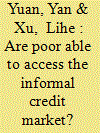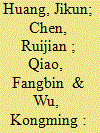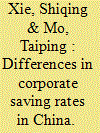|
|
|
Sort Order |
|
|
|
Items / Page
|
|
|
|
|
|
|
| Srl | Item |
| 1 |
ID:
143433


|
|
|
|
|
| Summary/Abstract |
This paper conducts an in-depth evaluation on the role of industrial agglomeration in productivity growth of China's industrial sector by exploiting large dataset of manufacturing firms active in 176 three-digit industries and in 2860 counties. We also complement our analysis with the 2004 Census data to capture the agglomeration of small firms. Unlike previous studies that often focused on specific industries, we assess the impact of agglomeration in a comprehensive range of industries and extend the scope of analysis to upstream industries as well. Moreover, we explore how the ownership of Chinese firms shapes their ability to benefit from agglomeration effect as well as to act as the source of externality. We find that congestion and fiercer competition offset the benefits of agglomeration for firms operating within agglomerated regions. On the other hand, a co-location of large firms contributes significantly to productivity. We also find a more important contribution from the agglomeration of upstream industries than from that of the same industry. Private enterprises are the primary source of agglomeration effects especially in upstream industries, whereas their productivity is boosted most by the agglomeration of other private enterprises. We reckon that industrial agglomeration contributed up to 14% of the productivity growth in China's industrial sector between 2000 and 2007.
|
|
|
|
|
|
|
|
|
|
|
|
|
|
|
|
| 2 |
ID:
143445


|
|
|
|
|
| Summary/Abstract |
The poor are often excluded from formal credit markets, but few empirical studies in literature have investigated whether the poor are constrained in the informal credit market. This paper uses recent micro data of rural China to answer this question. An instrumental variable model is estimated to account for potential endogeneity issues. Results show that poorer households have lower probability of entering the informal credit market. Further examination shows that the poor are limited by social network and that they have no financial means to invest in their social capital to expand their social network. Our findings shed light on potential solutions of reducing poverty in rural areas.
|
|
|
|
|
|
|
|
|
|
|
|
|
|
|
|
| 3 |
ID:
143439


|
|
|
|
|
| Summary/Abstract |
The November 2008 Chinese stimulus package seemed to provide almost ideal preconditions for governmental success based upon its size, its concentration on infrastructure, accompanying fiscal expansion at the local level, and supportive expansions in bank lending rates. Our sectoral-level analysis suggests that investor reactions were quite tightly focused, however, with Shanghai market outperformance concentrated primarily in the nation's property, construction, and building materials sectors. Further significant post-stimulus gains accrued to the specifically targeted automobile, steel and textile industries. Meanwhile, Chinese company listings in Hong Kong and New York evinced little sectoral outperformance.
|
|
|
|
|
|
|
|
|
|
|
|
|
|
|
|
| 4 |
ID:
143434


|
|
|
|
|
| Summary/Abstract |
As the rapid development of Genetically Modified crops, Chinese government has been increasing its efforts in GM crop biosafety management. However, the rapid expansion of Bacillus thuringiensis (Bt) cotton varieties and less regulated seed industry also resulted in a large amount of Bt cotton varieties that bypassed China's biosafety regulations. This study shows that the Bt cotton varieties without biosafety certificates (BC) have been widely used by farmers in practice. Econometric analysis further shows that the Bt cotton varieties with BC outperform the varieties without BC in terms of pesticide use. The paper concludes with policy implications.
|
|
|
|
|
|
|
|
|
|
|
|
|
|
|
|
| 5 |
ID:
143431


|
|
|
|
|
| Summary/Abstract |
Using the data of the listed non-financial companies from 2003 to 2012, this paper conducts a firm-level empirical analysis to reveal the determinants that lead to differences in saving rates of different enterprises in China. Particularly, we explore the discrepancies in the Chinese enterprises' saving rates from the new perspectives of ownership type, monopoly status, and financial development. We find that only some financial indicators of a firm, including the size and the long-term solvency ability, have direct impact on its saving rate. Besides, the difference in the saving rates between private firms and state-owned firms is insignificant while monopolies have higher saving rates than non-monopolies. Most importantly, financial development generally reduces a firm's saving rate and the impact is independent on its ownership type and monopoly status. Moreover, financial development decreases the influence of a firm's short-term solvency and profitability on its saving rate.
|
|
|
|
|
|
|
|
|
|
|
|
|
|
|
|
| 6 |
ID:
143437


|
|
|
|
|
| Summary/Abstract |
The distributional impact on households is an important factor for the acceptance of energy subsidy reform. Based on energy consumption features of the Chinese households at different income levels, this paper adopts an input–output price model to analyze possible impacts of removing energy subsidies on income distribution under different scenarios. Results show that: (1) The distributional impacts of removing subsidies vary by fossil fuels. From the perspectives of combined effects, transport fuel subsidy removal and coal subsidy removal have the strongest and the weakest progressive effects respectively, while the removal of electricity subsidies has a regressive effect. Moreover, the removal of petroleum product subsidies has the greatest impact on households, followed by the removal of electricity and coal subsidies, respectively. (2) Indirect impacts of energy subsidy reform are greater than direct impacts on households. (3) Government price controls can reduce the negative impact of energy subsidy reform. Policy implications are thus summarized. Energy subsidy reform can start from the energy that has the strongest progressive effect and the minimum impact on households. The Chinese government can take certain compensatory measures to mitigate the impact of reform on poor households.
|
|
|
|
|
|
|
|
|
|
|
|
|
|
|
|
| 7 |
ID:
143441


|
|
|
|
|
| Summary/Abstract |
This paper analyzes whether hospital competition is associated with improved health care delivery in China, particularly in the dimensions of health care quality and cost. We explore the differences in competition over time and across regions to examine the relationship in an environment wherein the hospital industry is largely state owned, the price of medical care is partially regulated, and hospitals can compete on both quality and cost. Using provincial- and individual-level data, along with a set of outcome indicators, we find that hospital competition is significantly correlated with lower observation room mortality, shorter outpatient waiting time, and fewer outpatient costs, while we do not find evidence that would suggest negative influences of competition on the other measures of hospital performance. Our results offer new evidence in support of competition-based reforms in China's health care sector and provide implications for other developing countries facing similar health care challenges.
|
|
|
|
|
|
|
|
|
|
|
|
|
|
|
|
| 8 |
ID:
143438


|
|
|
|
|
| Summary/Abstract |
This study uses panel data on the Bohai Rim Region of China to test for spatial autocorrelation, and measures economic spatial spillover effects with the space Durbin econometric model. We discuss whether the economic development of coastal counties benefits the whole area. To do this, we focus on the “distance from the coast” factor, which is influenced by transportation time. The results indicate the presence of significant spatial autocorrelation in the Bohai Rim Region. Further, economic spatial spillover effects exist in this region. “Distance from the coast” exerts a significantly negative impact on the local GDP per capita but a significantly positive impact on the GDP per capita of other districts. This means that the economic development of coastal counties does not benefit the whole region. “Value of exports” exerts a significantly positive influence on the local economy and no significant influence on other counties, while “foreign direct investment” exerts a significantly positive influence on the local economy and a significantly negative influence on other counties. “Number of employees in units” exerts a significantly positive influence on the local economy and a significantly negative influence on the other counties. The factors “primary industry's share in GDP” and “tertiary industry's share in GDP” influence the local economy positively, but the former exerts no significant influence on other counties and the latter exerts a negative influence on other counties. “Rate of fixed asset investment” influences the local economy negatively and has no significant effect on other counties. “Total retail sales of social consumer goods” has no significant influence on the local economy but a positive significant influence on the others. Finally, marine resource utilization and marine output can affect economic growth positively. On this basis, we propose policy suggestions for harmonious economic development in this region.
|
|
|
|
|
|
|
|
|
|
|
|
|
|
|
|
| 9 |
ID:
143443


|
|
|
|
|
| Summary/Abstract |
Intergovernmental transfers are an important source of local public goods and services provision in many developing countries. Yet the empirical evidence on their effectiveness remains inconclusive partly because transfers are endogenous to political influence. This paper investigates the impact of a mix of intergovernmental transfers from a large-scale poverty relief program on local education spending in China between 1994 and 2000. Using a fuzzy regression discontinuity design, I first show no systematic evidence that counties benefiting from the program enhanced local education spending during the period of program implementation. I further show that the program has neither short-term nor long-term impacts on illiteracy reduction for the targeted counties.
|
|
|
|
|
|
|
|
|
|
|
|
|
|
|
|
| 10 |
ID:
143444


|
|
|
|
|
| Summary/Abstract |
Using several waves of the China Health and Nutrition Survey (CHNS), this study analyzes the effect of long work hours on health and lifestyles in a sample of 18- to 65-year-old Chinese workers. Although working long hours does significantly increase the probabilities of high blood pressure and poorer reported health, the effects are small. Also small are the negative effects of long work hours on sleep time, fat intake, and the probabilities of sports participation or watching TV. We find no positive association between work time and different measures of obesity and no evidence of any association with calorie intake, food preparation and cooking time, or the sedentary activities of reading, writing, or drawing. In general, after controlling for a rich set of covariates and unobserved individual heterogeneity, we find little evidence that long work hours affect either the health or lifestyles of Chinese workers.
|
|
|
|
|
|
|
|
|
|
|
|
|
|
|
|
| 11 |
ID:
143440


|
|
|
|
|
| Summary/Abstract |
This study presents evidence of the renminbi's growing influence in the Asia-Pacific region. The CNH market – the offshore renminbi foreign exchange market – is found to exert an effect on Asian currencies that is distinct from that of the onshore (CNY) market. Changes in the RMB/USD rates in both markets have a statistically and economically significant impact on changes in Asian currency rates against the US dollar, after controlling for other major currency moves and the transmission of China's monetary policy to the region. The continuing growth of the offshore renminbi market points to rising influence of the CNH market, but how long the independent impact will last will likely depend on China's progress in liberalising its capital account. The findings also suggest that China's regional influence is increasingly transmitted through financial channels.
|
|
|
|
|
|
|
|
|
|
|
|
|
|
|
|
| 12 |
ID:
143430


|
|
|
|
|
| Summary/Abstract |
This paper provides an empirical exploration of the interaction between fiscal policy, monetary policy, exchange rates, and external balances as well as their impacts on real economic growth and inflation for the BRICS countries. A panel VAR model is employed to assess the dynamic relationships. Our results generally confirm the significant impacts of a monetary shock on real economic activity but the effect of fiscal policy appears to be much weaker from the cross-country perspective. We do not find evidence supporting the “twin deficits” hypothesis but the positive interaction between inflation and interest rates – the “price puzzle” – is documented. When bilateral exchange rates and trade deficits (vis-à-vis the US) are used, we find that the BRICS–US bilateral trade balances do not react considerably to currency depreciation shocks, indicating that exchange rates may not play a critical role in the adjustment of large trade deficits for the U.S.
|
|
|
|
|
|
|
|
|
|
|
|
|
|
|
|
| 13 |
ID:
143435


|
|
|
|
|
| Summary/Abstract |
Using hand-collected data on IPOs by private-owned enterprises, this article examines the regulatory benefits of political connections in China's state-controlled going public process, a subject that has rarely been investigated in existing literature. This article makes the following findings: first, political connections have significant positive impact on enterprises' chances of being approved for IPOs; second, enterprises with political connections are significantly more likely to receive preferential treatments (e.g., higher offering price-to-earning ratio) from regulatory authorities; third, enterprises with political connections are significantly less likely to be selected for pre-IPO on-site auditing by regulatory authorities. The findings of this article may provide answer to the question why China has been so reluctant to adopt disclosure-based regulatory regime as well as insights into the puzzle of the consistent poor performance of China's stock markets.
|
|
|
|
|
|
|
|
|
|
|
|
|
|
|
|
| 14 |
ID:
143446


|
|
|
|
|
| Summary/Abstract |
Using a survey of 19,977 children in two provinces, this paper explores the prevalence, correlates and potential consequences of poor vision among children in China's vast but understudied rural areas. We find that 24% of sample students suffer from reduced uncorrected visual acuity in either eye and 16% in both eyes. Poor vision is significantly correlated with individual, parental and family characteristics, with modest magnitudes for all correlates but home province and grade level. The results also suggest a possible adverse impact of poor vision on academic performance and mental health, particularly among students with severe poor vision.
|
|
|
|
|
|
|
|
|
|
|
|
|
|
|
|
| 15 |
ID:
143432


|
|
|
|
|
| Summary/Abstract |
The present study uses firm survey data of 1033 manufacturing firms operating in Ethiopia in 2011 to examine the impact of Chinese outbound direct investment on the productivity of domestic firms. Particularly, we attempt to answer two questions. Firstly, are Chinese-owned (henceforth foreign) firms more productive than local ones? Secondly, does the presence of foreign firms generate technology spillovers on domestic firms operating in the same industry? Our empirical results show that foreign firms are more productive and that their presence has different spillover effects on the productivity of domestic firms. In particular, we find that domestic firms with higher absorptive capacity experience positive spillovers, while those with low absorptive capacity witness negative spillover. We also find that small firms and non-exporting firms benefit more from spillovers than do other types of domestic firms. In this study, instrumental variables are used to address the potential endogeneity between foreign firm presence and domestic firm productivity.
|
|
|
|
|
|
|
|
|
|
|
|
|
|
|
|
| 16 |
ID:
143436


|
|
|
|
|
| Summary/Abstract |
This paper investigates the changing nature of economic integration in China. Specifically, we consider business-cycle synchronization (correlation of demand and supply shocks) among Chinese provinces during the period 1955–2011. We find that the symmetry of supply shocks has declined after the liberalization initiated in 1978. In contrast, the correlation of demand shocks has increased during the same period. We then seek to explain these correlations by relating them to factors that proxy for interprovincial trade and vulnerability of regions to idiosyncratic shocks. Interprovincial trade and similarity in factor endowments tend to make shocks more symmetric. Surprisingly, foreign trade and inward FDI have little effect on the symmetry of shocks.
|
|
|
|
|
|
|
|
|
|
|
|
|
|
|
|
|
|
|
|
|